#lots of really weird synergies in this deck
Explore tagged Tumblr posts
Text

committing sins against god
#lots of really weird synergies in this deck#kitt and kerass are level 2s so you can make easy rank 2s with them and the ojamas#fraktall can send an ojama instead of a tri if you need it for ojamassimilation (which is also 4 tri types in gy/banish for revolt)#ferijitt and bearbrumm can shuffle any ojamas you drew and replace them with something actually good while also making ojamagic live#ojama red can make easy link spams for tri brigades since they're all beasts (or just a 4 mat apollousa if you're feeling silly)#all these upsides and you're still somehow playing a worse deck than pure tri-brigade
2 notes
·
View notes
Text
I no longer make YouTube vids discussing Lorcana news (no one watched them and they have zero rewatch value) so now I go to tumblr. We got a new set announcement! AZURITE SEA!

The vibe is PIRATES. So like Into the Inklands, but more so. No new mechanics revealed, though hopefully there will be something. We do have two new franchises, though! Big Hero 6:

and Rescue Rangers:

Neat! Okay let's get into the cards that may actually see any play.

This may see play in Amber/Amethyst aggro decks, which are already running the Bodyguard Donald with the same ability. The Bodyguard is very useful for protecting high-lore low-stat squishies, but having twice as much of that ability is very very nice.

As we'll see in a bit, this is the first time we're seeing any sort of "milling" (discarding cards from decks) in Lorcana. I like this because it synergizes with Chernabog. I'm wondering if we'll be seeing more cards that jive with this archetype.

We've seen two each of Chip and Dale, and if we get more of them, there might be enough synergy for a "tribal" deck. If that happens, you will definitely want this guy, he's got great stats for his cost, and he's inkable! Unlike last set's Moana.

Not the worst thing. She survives Brawl, which is important. But she's definitely not surviving a challenge. Most Amethyst decks are never going to have fewer than 3 cards in hand, though, they already have so many other card draw tools. Honestly the most likely spot for her might be Amber/Amethyst aggro - drop her turn 4, your opponent is going to be focused on your squishies, and you get to refill your hand on turn 5.

So this is a weird one. There is an existing Emerald/Steel deck that wants to play A Whole New World a lot of times, and technically that's "milling" in that it's forcing your opponent to lose by running out of cards to draw, but now this is actual milling. But... it's only one card. This is going to need a lot more support for this to actually see any play at all.

This seems really good, and a much better payoff than the uninkable Robin Hood from last set ended up being. This could net you a lot of lore, and might be the start of an Emerald burn deck.

Speaking of Emerald burn, this is one of the best 1-drops I've ever seen. I want to combo this with floodborn Kida and some sort of Reckless.

Lorcana has been real hesitant to do tutoring to hand, but even just ensuring you topdeck, say, Lucky Dime, could be very useful.

This just seems like a solid overall card, aside from the Brawl vulnerability. Will we finally see an Inventors deck?

This is amazing. Ruby/Sapphire self-damage/heal deck. This may finally work where Grand Pabbie just didn't.

The card is "okay" at best but I love the flavor/art lol

That is a pretty easy condition to meet, and they don't even need to be exerted. Just have this in an Alien and/or Robot deck and have it passively spit out lore for you, shunting in a new character every turn.

Saving the best for last - JIMBO! Wow, what a card. Immune to Madame Medusa, and can draw you potentially four cards??? I would love to see an Amber Pirates deck (there's already the Piglet), particularly if we can get a cost reducer to get Jim here out earlier.
Set comes out in November!
23 notes
·
View notes
Text
All For Nothing: Zero Commentary
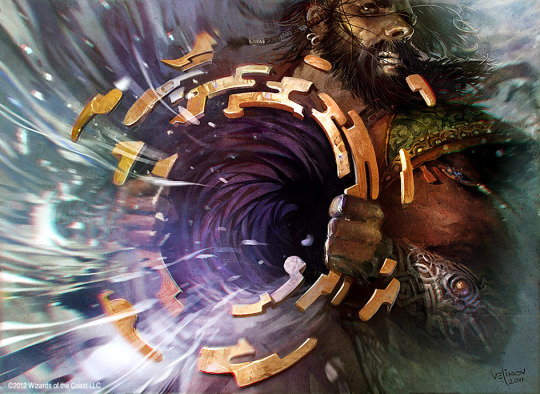
Alright, and that's a wrap! I'd just like to thank everyone once again for all their entries this week, it really made my first stint as a judge a truly unforgettable experience. I encouraged you all to get weird with it, and by golly if you folks didn't deliver in spades. With that said, though, I feel as though there's a fine line between "weird" and "excessive." Not to say any of you crossed it, of course, it's just something to keep in mind.
But enough prattle, let's get into the thick of things!

@bergdg — Pact of Annihilation

Okay, first things first: four of these in your opening hand is a turn 1 kill. That's an easy fix, of course, just need to adjust the numbers down a tick. That aside, though, this is a lovely little piece. A pact is a natural fit this week, and this one feels more quintessentially red than the one we currently have. Very much calls to mind Pyrokinesis, although it's not without an identity of its own. Centrally, trading the card disadvantage of Pyrokinesis for the delayed payment makes the decision intriguing, and giving it the ability to hit players in exchange for a strict two target cap is super smart. It's a solid design all around, cheesy OTK notwithstanding.
~
@curiooftheheart — Belzym, Veteran Grafter

This is just a big ol' bundle of all things Simic, huh? Graft and Coiling Oracle, together at last. Right out of the gate, I want to say that I really appreciate the commitment to asking for specifically 0/0 creatures, rather than just either/or. That does a lot to instantly inform deckbuilding around this, but it's still open enough that players can have a "Eureka!" moment when they discover the perfect card for the strategy.
I'm not quite as sure about the reward, though. As much as I appreciate the Coiling Oracle callback, as I said, it feels a bit disconnected from the condition besides the ongoing green-blue commitment to "do thing, get value." I could maybe see the logic be that scaling X creatures like hydras would want the ramp, but with the card so flavorfully tied to graft, I don't think that quite resonates.
~
@hanavesinauttija — Rogkhar, Kher Keep Raid Leader

Next in the storied (which is to say, unfortunate and short-lived) line of Kheer Keep kings, here comes Rogkhar, shouting their little head off. We've seen extra combat effects with a degree of specificity before—Akki Battle Squad springs to mind—but none quite so specific as this one! With that said, as much as I appreciate the joke, part of me does think this should cost some amount of mana. Even if nothing gets to attack, there's a surprisingly high number of uses for an extra combat step, especially with all the effects these days that trigger at the beginning of combat. Not to mention the extreme synergy with hydras and their ilk, which wouldn't be quite as much of a problem if this couldn't be thrown into literally any deck that could want it. In a similar vein to Phyrexian Metamorph, it allows for an effect that's very strongly tied to its colors (in this case, extra combats) to bleed outside of it, which is potentially dangerous. Even just one red pip would go a long way, but I do really want to see this little guy succeed.
~
@helloijustreadyourpost — Mindbreak Phoenix

I can't think of many phoenixes that simply allow you to cast them from the yard rather than tying their revival to a trigger, but I also can't think of any other way to make this hellbent, so I won't hold it against the card. Among the most aggressive phoenixes I've seen, too, which is saying something. This thing isn't about to give your opponent a moment to breathe, and even though its defenses seem paper thin, it'll just keep coming back given half the chance. Tying the discard to being blocked is super smart, too. Suddenly, blocking this thing can almost hurt more for your opponent than letting it through, because not only will they have to lose something, but it'll bring you closer to just being able to recast the dang thing. Wicked!
~
@hypexion — Spectral Host Prelate

Spooooky. The idea of Phyrexian Spirits is pretty suitably terrifying. I'd say this would fit snugly in defender decks if it weren't for the incubator. In general, I think the incubator might verge on a bit of a misdirect? Outside of precisely Brimaz, incubators are generally intended to be large vanilla creatures. So, in decks built around them, the spirit may end up feeling less like a compelling reason to sacrifice them and more like consolation prize when they get removed. That's not an actual knock at that gameplay, just a bit a communication issue. And who knows, I might be overblowing it. On a gameplay level, though, this runs into the problem that if you can reduce the spirits' power to 0 through an aura effect, you've suddenly got an infinite chain of spirits, which probably necessitates a contingency. Sorry if that got a bit negative. I really like what this card is doing, I just feel like the card itself doesn't quite get that across all the way, y'know?
~
@jestingmaniac — Sanity Blast

Well, this certainly lives up to its name! Just roll your sanity into a ball and spike it at some poor sap like you're in gym class and they just said something particularly unflattering about your mom. That said, I think this actually might be a bit too much cost for the output you're getting. Discarding cards is usually used as a substitute for other costs, and discarding your hand even more so. Not being able to target players is smart, but limiting this to just a single target feels like a bit much. It'd have to be a very big creature that throwing your entire hand at it wouldn't feel like comical overkill. Some way to target additional permanents—or even just making this a full-on boardwipe—would go a long way, I fell. You're on the right track to making something bombastic here, but take care you don't blast your own sanity too.
~
@just--a--penguin — Untimely Creation

We've seen plenty of mana rocks that can animate themselves over the years, but none quite so extreme as this one. I love the idea that it only gets up the moment right before you die, but I'm seeing a few rickety parts in the execution. The idea of sitting at zero life as a last chance hit point is great, but the fact that it requires you to hit precisely zero to work means it seems like it wouldn't actually happen much. Perhaps make it a one-time version of the Fortune Thief effect to lock you at 0? The body it becomes, then, is suitably large, but without evasion or defensive utility, it may struggle to close out the game or stand fast against the presumable army bearing down on you. I love what you're doing here, but it's just not quite there.
~
@misterstingyjack — Zeke, Zero Theorist

In contrast to some of these cards, this one is comparatively quite straightforward. Make big modular creatures, swing in for big number, with an attached fractal to jumpstart the process. Especially with how big some hydras can get, the ability to just entirely sidestep blockers is quite fearsome. Straightforward is good, though! It's clearly stating what it wants you to do with it, and a lot of people will be drawn to it. The one part where I think the straightforwardness hurts it, though, is the choice to use fractals. Fractals made a name for themselves by having all sorts of weird ways to scale their power that were often completely unique to the card that generated them, so a flat X/X feels...not bad, just stings of missed potential.
~
@mudthing — Possibility Tender

Next up is this adorable little sprout, here to teach us about the importance of the number zero, and also the importance of scale. A mana dork that draws you cards is certainly a tempting prospect, and we've seen this kind of design before, where it rewards you for spending the mana on a specific type of spell. A word of caution, though: the existing versions of this effect (specifically Battery Bearer and Gilanra, Caller of Wildwood) both require you to cast high-cost spells to draw cards, which require high commitment and can't be cast until later in the game. Comparatively, casting a zero power creature every turn is far more achievable, which means this has the potential to produce a truly dizzying amount of value, even more so with multiple copies. A higher mana cost or a reward a bit smaller than drawing a card could do a lot, though!
~
@nine-effing-hells — Aspect of Progenitus
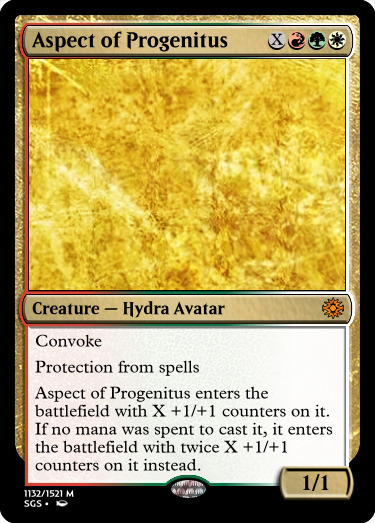
With all this talk of hydras, you'd think there would be more hydras this week than just the one, but oh, what a hydra this is! Protection from spells is a really clever derivative of Big P's protection from everything, and the shift from five colors to just Naya feels so natural as to just be a no-brainer. This is another one of those cards that encourage you to convoke them down to zero, but having these be a modular spell rather than a fixed cost you have to chew through changes the gameplay significantly. Suddenly, it's not a binary yes/no decision, and there's a whole range of options depending on exactly how much of each resource you have available. Oh, I just adore it! I can feel confident saying that no matter what you put into this, you'll feel like you got your mana's worth, which is always the place to be for X spells.
~
@partialgardens — Unity
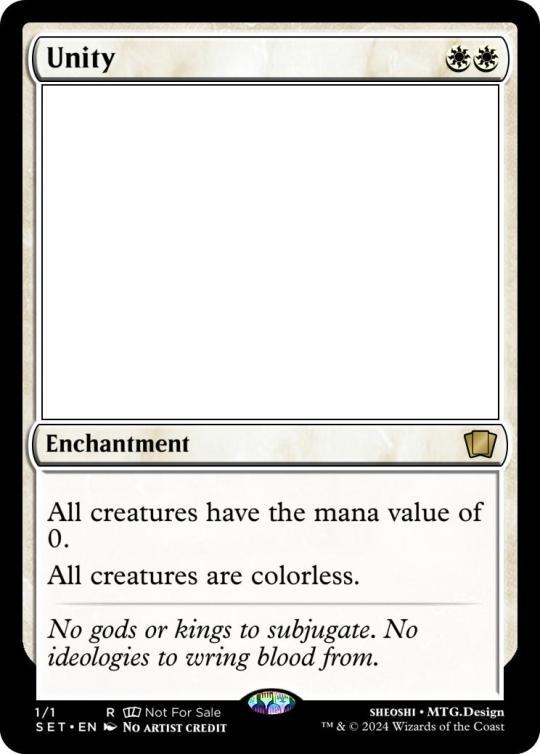
This is a strange one, to say the least. Mana value isn't a characteristic Wizards has every really explored, although there's technically nothing stopping you from messing with it. The card on the surface reads like a hate piece, but I struggle to actually call it that. You said in your submission that you intended it to synergize with all the removal that only targets creatures with low mana value, and I can kind of see that...but the larger problem is, the only cards that care about the mana value of creatures on the field are more or less those removal spells, or otherwise cards meant to be pointed at your opponent's stuff. So, I can't think of many situations where this disrupts someone's strategy based on that. The color removal is more on the right track, but it's still very specific, and actually works against the swathe of white effects that care about white creatures. A fascinating concept, but I think this is crying out for some amount of objective power if you want the effect to be this specific. Even something as simple as attaching it to a body or having it draw on entry.
~
@phyrexiandreadthot — The Void Engine

To say the least, this one's a house and a half. Hoo boy. Okay so, first off, I appreciate the forethought to have a measure against cheating this out, but I fear you may have gone a bit lenient with it. For one, plenty of decks have no issues hardcasting this early. I'm sure any tron player would salivate at the idea of casting this on turn 3 and promptly dumping their entire hand onto the table. Also, the fact that this only wipes the once means it's entirely possible to just rebuild afterwards (aided by the obscene discounts this gives you), even if it didn't also hamstring your opponent. It also crucially misses nonland permanents that produce mana, meaning that careful setup could make this barely set you back at all.
Beyond that, the fact that the cost reduction applies to abilities as well, and without the clause seen on cards like Training Grounds that prevents the cost from being reduced below one, means this is liable to create all sorts of hilarious infinite combos (every generated infinite black mana with Initiates of the Ebon Hand?). As I mentioned earlier, the Praetor-like reflection of the effect on your opponent is positively crippling, ratcheting up every cost they pay as much as double. Furthermore, this also means that the best counter to a Void Engine is another Void Engine, as colorless decks are hit the hardest.
On a rules level, while the effects groks well, "generic mana costs" are still mostly unexplored in the rules. As well, "rather than pay" as language usually refers to replacing an entire cost, rather than a part of it. All in all, this is a crazy ambitious design that I respect the intent of, but I think you may have flown a bit too close to the sun.
~
@railway-covidae — Miser's Bargain

I really want to love this card, and it's so, so close, but it runs into one crucial issue that plagues so many designs: memory. Every effect so far that modifies hand size is either a static ability of a permanent, or sets that number to infinity. Without any built-in aid, tracking whichever number between 0 and 7 you set your maximum hand size to across multiple turns sounds like a headache, and can possibly even cause irreparable gamestates if you end up forgetting. The effect is gorgeous, though, presenting a real spectrum of choices that has merits in choosing either end. Although, I'm not sure for what reason besides symmetry you' allowed people're allowed to choose 7, given that causes the spell to resolve without effect. Oh, and also tasteful reference to the obscure Miser cycle from original Kamigawa. Those guys are neat!
~
@real-aspen-hours — Teachings of the Void

First off, it's "you draw a card and lose 1 life." Sorry, that's the pedant in me speaking, and I see that mistake a lot. The rest of me, though, says that I like this card a lot. I love the tension of a card that ideally wants you to have an empty hand, but draws you cards. Naturally the best way to play it is to simply empty your opponent(s) hands with discard, but the fact that you also have to find a way to empty your own hand every turn to get the best results is a fascinating play pattern. I'm not entirely confident in the decision to make this an uncommon, though, especially paired with the ETB effect. That, or maybe adjust the cost just slightly up. Just minor tweaks, though! The core here is very strong.
~
@wifeswarmacademy — Shoo Away
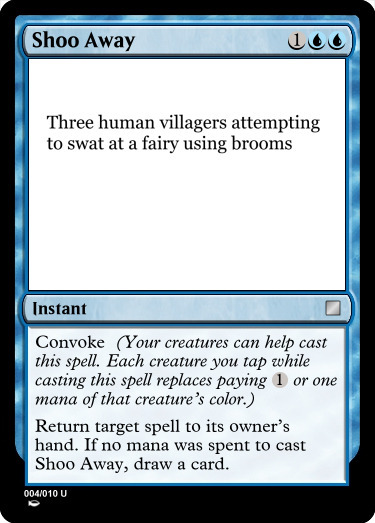
The name and the flavor here are great, immediately. Following on the heels of such stars like Access Denied and Didn't Say Please, it's always fun to inject of bit of levity into your countermagic. The card's all-around solid, too, though I will say that leaves me wanting a bit more. Specifically, Remand (and more recently, Reprieve) can do the same thing with fewer hoops to jump through, and I feel that this one would stand out more with a reward just a little more bombastic than drawing a card. Convoke on countermagic is a bit tricky, too, as holding up creatures is far less visible to your opponent than holding up mana, which could potentially create some pretty feels-bad moments. Although, there aren't many examples of it yet, so I'm really just speculating. Now, shoo!
~
@wildcardgamez — Voidheart Core
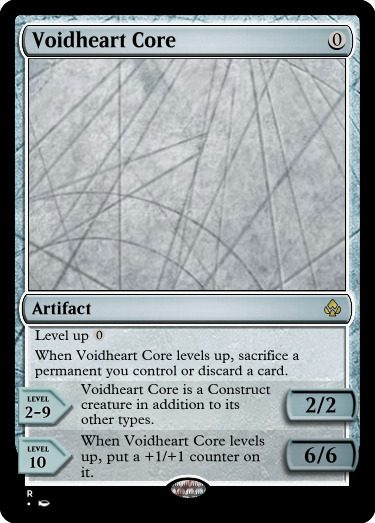
An alternate level up cost, eh? Well, you've certainly got my attention right out of the gate. The fact that it's not a creature until it's levelled up is also a fascinating twist. A manaless 2/2 that requires you to sacrifice some resources is pretty hefty, but perfectly workable in the right deck. It's past that you start to lose me, though. Eight more sacrifices to boost it up to a vanilla 6/6 is a huge ask, and I'm not sure how much you're liable to have left to sacrifice once you get there. Level up is famously hard to judge without playing with it, though, so I'll give it the benefit of the doubt and leave it at the fact that I love the concept.
~
That's zero entries left, and I'm feeling pretty zeroed out myself. See you next time!
@spooky-bard
8 notes
·
View notes
Text
Krenko’s Guide to Creature Types: Orc

Art by Darren Tan
What is a Orc (flavorfully)?
Orcs are basically larger, stronger, more ferocious Goblins. They’re known for being brutish, ferocious, impulsive, stupid, and basically everything Goblins are except that they’re big enough to back it up on an individual level rather than needing to swarm. The reason they’re so much like Goblins is that classic Orcs ARE Goblins and it wasn’t until 1977 when Dungeons and Dragons decided they were different. Since then, the modern idea has been that Goblins are the small ones, Orcs are the medium ones, and Ogres, which are also historically the same thing, are the large ones. While this line of thought has mostly been accepted into modern culture, it’s not a hard and fast rule and it’s often not codified at all in things that aren’t directly from the D&D lineage. Orcs just being big goblins was extremely obvious in the early sets, where cards like Orcish Librarian and Orcish Settlers used the commonly repeated Goblin joke of being really bad at their stated job.
Orcs in Magic: the Gathering appear sparingly on Dominaria and heavily among the Pirates of Ixalan and the Mardu/Kologhan Clan of Tarkir. Population density on Arcavios is unclear, but there are a few at Strixhaven University. As a D&D race, they’re also featured in Forgotten Realms sets.
What is an Orc (mechanically)?
Orc is a racial creature type, usually for Black or Red creatures with power and toughness in the 2-4 range. Forgotten Realms Orcs are often other colors, but Forgotten Realms does a lot of weird things to match the D&D flavor. All the Orcs in MtG worlds are Black and/or Red, at least.
Orcs have a high instance of the Dash ability, but this is primarily due to being so heavily focused on the faction it belongs to. Most Orc abilities seem to be based more on their faction than the identity of being an Orc, though they do seem to have a higher than usual instance of cards that use drawbacks to get more power.
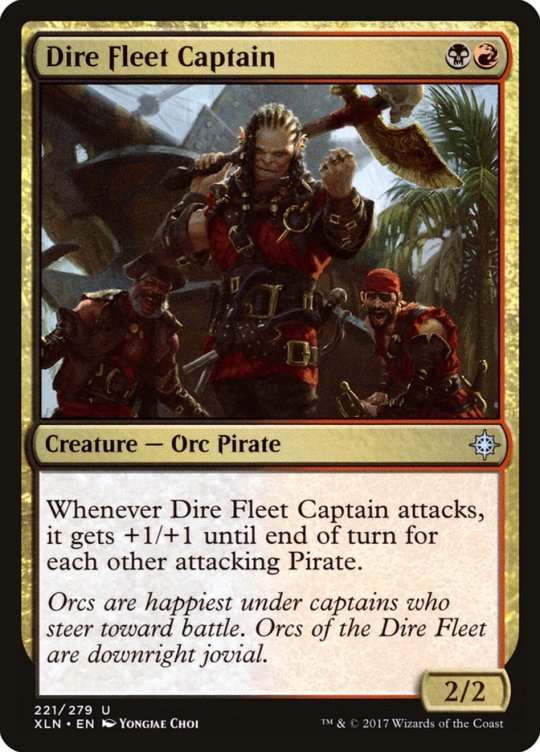
Can I make an Orc deck?
Despite very little Orc tribal support or synergy, Orcs come with enough raw Red/Black aggression that putting a pile of them together to turn sideways is perfectly viable. That said, if you actually want to make a competent deck full of Orcs, you’re better off ignoring Orc tribal and either going Pirate tribal or making a Mardu/Khologan faction deck. You’re going to get a lot of Orcs either way, but the best support Orcs are cards like Dire Fleet Neckbreaker and Warbringer that support faction rather than all Orcs. The only actual Orc Tribal cards, Orc General and Orcish Captain, aren’t even better than the artifact ‘choose a creature type’ rewards.
In Commander, you’re using Zurgo Helmsmasher. He’s one of the best Orcs on his own and he’s in all the colors you actually care about. Yes, there are other Legendary Orcs, but the only other one with an argument is Sek’Kuar, Deathkeeper, and the White splash is far, far better than the Green splash here. With the handful of Orcs printed in Commander Legends, Orcs actually have a bit extra going on in a multiplayer format.

Is Orc a good creature type?
Orc is not doing great. Their identity of mid-sized black/red creature is interesting, but they don’t have enough in there to call their own. They operate on the ground between Goblins and Ogres without any traits to really set them apart from either, but Goblins can get as big as Orcs and Ogres can get as small as them, so Orcs are just fighting for design space with both. Orcs having drawbacks to gain more benefit is a good idea, but it’s certainly not being leaned into, and for whatever reason we’re seeing Orcs in Blue and White now, which just muddies what an Orc is even further.
Now, people like Orcs, I get that. Thanks to D&D inspiring Warhammer and that being blatantly ripped off into Warcraft, Orcs have a huge space in modern culture, but they’re just not doing anything in Magic. Wizards does seem committed to printing more Orcs, but this commitment doesn’t seem to include a willingness to define the Orc as something other than a Goblin/Ogre, and Ogre is historically just Orc in French.
My personal opinion is that for gameplay purposes Orcs and Ogres should just be the same tribe, but that’s not a fight I’m going to win, so I think Wizards needs to stop printing off-color Orcs and lean more heavily into the idea of Orcs as a tribe with a lot of strength and a lot of drawbacks. Mardu Outrider, which doesn’t even exist in paper, feels like a perfect Orc to me and I’d love to see more like that.
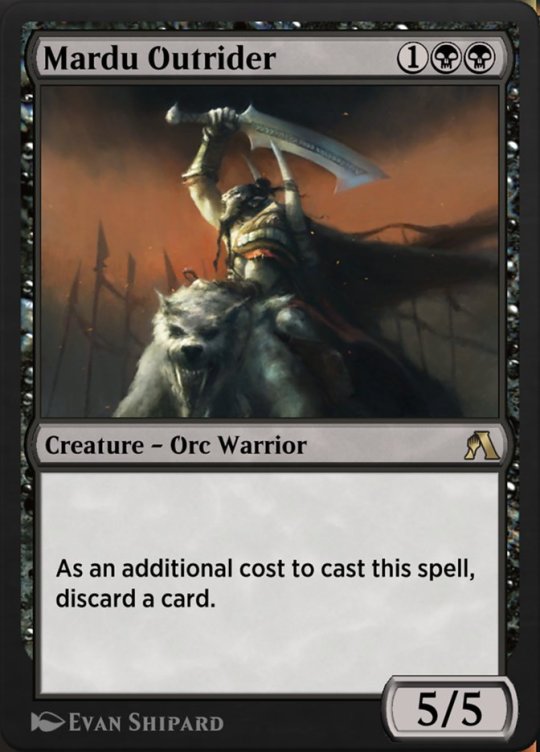
29 notes
·
View notes
Text

I didn't know about this! It was a message from Oda about the TCG's release. Mostly fluff, but it's cute he's acting like he thought the characters come out of the cards like Yugioh. We're five sets in now. Six really since it's out in Japan. OP is my fifth TCG I've taken an interest in. The very well-designed but short lived Yuyu Hakusho one was done by this point. Magic with six sets is unrecognizable compared to the game it is today, same with Yugioh and Pokemon. I think they've managed it well so far. Cards from set 01 are far from outclassed. Keeping things built around leader archetypes is great for balance. But we are starting to get more complex.
The game is very fun, it's held up ecause the core mechanics are sound. It has a nice back-and-forth. A lot of games are won or lost on decisions to press the attack or hang back and build up for a bigger strike. Damage translating into who received it gaining cards is smart design. Opposite of Pokemon, where prize cards snowball a player doing well. If you give up on the early game damage and lock everything down, you have to usually survive a turn after you had to give your opponent 3-4 extra cards. Aggro gets a boon from not caring about early damage. Even when you're tapped out of resources most decks can still inch closer to a win or do something by loading up their leader on don and dropping a big attack.
Still think the "metagame" doesn't represent the best decks you can actually build yet. Seen it before, the card pool is outstripping people's experience. Too much focus on evaluating the best cards in a vacuum and just shoehorning those in. The designers have really done a great job working in fun ideas around some of these leaders. If you look at the full card list on the website it usually isn't hard to figure out which leader some of these are intended to work with. Don't feel like you need to chase the new hotness every step, this is definitely the type of game that rewards taking the time to learn every synergy and line of play a deck bult around a strong theme can get.
Collecting is fun too. I haven't done that in years. Dangling alternate arts for people that will throw thousands to have whatever the rarest cards are is great for accessibility. But there are so many cool promos! And it's always great to get a nice artwork for a beloved character. Even if it's just a game I play every now and then with my sweetie, it's weird...I just like having a deck to tweak or flipping through a binder. It's soothing. I'm glad I picked this up, looks like we'll have a local store starting up tournaments soon.
5 notes
·
View notes
Text

I have finally built the swarmlord! After months of debating, in a different house, after one accidental report of the original post, it is complete! And I... Love it. The giant creatures, the advantage, the synergy, the gender contained within these weird giant bugs! It's a work of beauty! There's something just magical in making a creature like a 20/20 and giving it trample, in playing simic ascendancy and saying that killing my commander makes me win quicker actually. Playing multiple grumgully effects and riot with hardened scales to increase every single iteration of +1/+1 counter gain. Looking back at my history in magic, there's a lot more green than I thought. Eldrazi ramp and Primordial Hydra as my key card in particular stand out. I mean my favourite deck was Orzhov Extort but I think if I had more time in kitchen table magic I'd be more partial to 'ramp out big creatures and attack'. And the cherry on top is the card advantage. How there are multiple 'draw cards equal to the highest power' in green, and FATHOM MAGE. Gods, fathom mage. That one card is making me reconsider simic as a colour combo. It's really really fun to pile counters on creatures! Finally found a blue deck I enjoy!
3 notes
·
View notes
Text
I want to tell a story
It’s a weird story about a bunch of silly things but mostly about metagames and Magic: The Gathering.
In terms of seriousness this is pretty much as unserious as can be. No one lost money, no one was hurt, no one probably thinks about this besides me, but this was one of the more fascinating weeks in my life and really influences how I think about game design as a whole.
Let’s dive in.
The year is early 2011. I am in my senior year of high school. As one does back then, I am playing Magic: The Gathering more or less daily. I’ve got a set of about seven friends all doing more or less the same, and we’re having a grand time of it. Mirrodin Besieged is coming out soon and we’re all down with Phyrexian madness. I’m graduating in a few months to go out to Massachusetts so I’m just chilling on a victory lap.
Importantly to those playing Magic today, but EDH/Commander, while a thing and popular, was not yet The Thing for casual Magic players. The commander decks had not yet come out (though had been announced and we were all hyped for them) and the shear density of legends was a thing of the future. Our format of choice was 60-card casual, either in duals or multiplayer. My traditional weapons at the time tended to be Naya decks with a lot of landfall and lifegain. You could expect two artifact synergy decks on the regular. Mill was a pretty common way to die. Times were good.
Our story begins in earnest with the release of Premium Deck Series: Fire and Lightning. For the unaware, this was an all-foil deck WotC put out that was, while crap in terms of reprint value today, a pretty stacked burn deck for a casual table. My one friend, labeled A here for convenience, had the most cards and had gotten this deck recently. It was very devastating in duals and we had an amusing time getting annihilated by Lightning Bolts, pingers, and various haste creatures. Then that deck went back into his collection and we resumed our previously scheduled nonsense.
But A was getting burnt out (heh). There’s only so many times you can play the same sort of matches before Magic gets stale, everyone who’s played the game knows the feeling. And so he goes searching the internet for something new.
2011, for those not playing, was possibly the absolute peak of Magic writing. Big name competitive players were playing weekly at the StarCityGames circuit and then writing about their new decks with cards that would skyrocket in value. Jace, the Mindsculptor was approaching his height of $100. The original dual lands, based on hype over Commander as well as Legacy being an actual format people played, were seeing a big rise as well. Due to this, there were several websites all vying for new, popular writers to make content that would push sales to their storefront of choice.
While a lot of this was competitively focused, there was also a ton of casual articles coming out as well. While again, EDH was a popular format, 50%+ of the articles being written were for various 60 card formats. 2-Headed-Giant and Emperor were things people did with regularity. Star was the pinnacle of multiplayer. And it is in one of the articles that A found the reason why this is being written, a format that I’ll be calling Pauper Vanguard League.
For the unaware, Vanguard is an established Magic format from way back in the day. The idea is that you have this avatar that alters your starting life, hand size, and gives you some ability. There were a couple printed and they’re kinda cool if wildly disparate in power level. This format gave people an amount of points to create their own vanguard. You could buy more life, more cards in hand, benefits for your creatures, reduced cost, whatever. This, A thought, would be the salvation, this would rekindle the spark. Plus, the fact that it was commons only meant that no one would get priced out, and you could change your deck with ease! So he brought it to the morning meetup before school on Monday, we read the article, all thought the idea sounded dope, and got to building when we went home instead of doing homework.
I don’t recall what the first deck I built was, probably something green and landfall based. I do remember that it was A who brought in a modified version of that Fire and Lightning deck and absolutely cleaned up. Not paying for any life beyond the base 10 and just upping his opening hand size meant that his opener had enough burn to kill pretty much anyone. It was crazy how brutal and efficient it was.
Tuesday comes along. Everyone knew who the top dog was. Burn was public enemy number one. Fortunately for me, you could buy abilities for all your creatures as part of your Vanguard. One of these abilities was lifelink. Excellent! I’ll give all my dumb green creatures lifelink, and that’ll do the trick. No more dying to burn!
But wait, I realized, why should I be playing green creatures anymore? The best strategy had been shown to us: Burn. I should be playing a Burn deck, but a Burn deck designed to beat the mirror. Make my Burn deck more creature-heavy, a little bigger, and give my creatures lifelink and haste. Boom, now burn spells to my face are terrible and I can just demolish the Burn decks that haven’t figured out the new rules.
And the metagame clock ticks one minute closer to midnight.
I arrive the next day and to the surprise of not me, everyone is rocking Burn but with different augments (you were allowed to minorly respec your Vanguard daily and we got more points daily too). I’m the only one who figured out the lifelink tech, but others are running +1/+1 to creatures, lower costs of spells, more life, all sorts of stuff. A’s burn deck is old news and demolished. I do pretty well, lifelink being very good in the Burn mirrors which were 75%+ of what I played that day. Satisfied, I go home, add some new abilities, and get ready for another day.
And the metagame clock ticks one minute closer to midnight.
Thursday morning comes. It does not take me long to realize that I too have now become the prey. People have switched from Burn and are now on White Weenie, buying the ability to use some number of uncommon cards. Have you ever played against a Silver Knight with +1/+1 and lifelink? While you are playing Burn? It was nightmarish. But there was some diversity. Some people were playing things like my green deck from Tuesday but with the anti-red tech. Some people were experimenting with artifact decks. But it was all focused on ensuring that Burn would not be a thing. Burn was now extinct.
That night I came up with a plan. The cards I was now fighting were small-medium creatures on the ground. They were played in large numbers but the decks had no staying power, being built to beat up on fast aggro decks. Despite being nominally cheap creatures, they were midrange decks in the metagame where everyone’s spells cost one less and every creature had lifelink.
My idea to beat these decks was to out-grind them. It was going to be Friday, and Friday was club day, so I needed a deck that would win because I was gonna play a lot. So I built a mono-blue deck. One-mana Mana Leak, two mana Divination and Cancel. Some walls. The deck was designed to stop others trying to play a proactive game and grind them out. Once I had the game under control, Ulamog’s Crusher with lifelink would annihilate them out of it.
And the metagame clock hits midnight.
It’s Friday and everyone realizes something has gone wrong. We are in a metagame where everyone is still tuned to beating red decks that no longer exist. The plot has been lost. I’m winning games, but I realize that it’s wrong, that the room is inbred to fight something and everyone is just hitting each other with bigger and bigger creatures. Someone figures out some new combination of abilities to next level everyone else but it doesn’t matter. We’ve hit the point of no return. This is The Metagame Disaster.
On the next Monday we agree to an alternative points system (probably should have found this one first) but everyone appears to agree that this experiment is over. We’ve got useless decks that literally do not function without specific rules in place. We switch back to our normal decks and try our best to move past last week.
It’s a day or two later that A admits to me that he’s been feeling burnout, and I suggest Type 4, a cube draft format where you have infinite mana but can only play one spell a turn. I turn him towards articles written by several people (yours truly included https://www.coolstuffinc.com/a/introducing-type-4 ), and he thinks it sounds fun as hell, builds a cube, realizes quickly that Compulsion is busto, and we all build different cubes to just play from the top of. Our final spring together continues with gusto and joy and we eventually get back into some more EDH and 60-card.
What did I learn here? Obviously, I didn’t take this all in at the time, but more and more I can see how it echoes into my game design philosophies. Given time, people will optimize the fun out of anything. Some things in games are worth more than others. Without some effects found at higher rarity, common games turn into grindfests. Rock-paper-scissors metagames only work if rock is allowed to exist by the game, and nerfs to “unfun” strategies can lead to even worse things popping up. Second-order effects are essential to consider in any closed system.
Oh yeah and most importantly play Type 4 it rocks.
0 notes
Text
Take on Fun Challenges and Crackup Hilarity in CosmoPirates
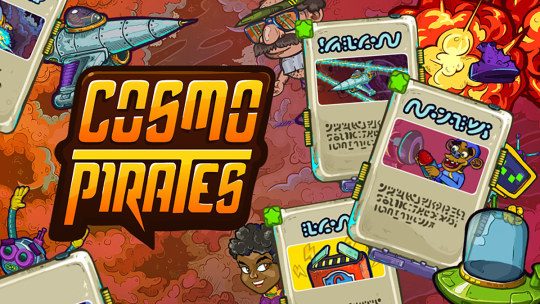
CosmoPirates comedy deckbuilder roguelike game now has a Demo for Linux and Windows PC. Thanks to BlackMoon Design for their imaginative work in bringing players such innovative and engaging design. Available to try out on Steam. I recently dove into the demo of CosmoPirates, a quirky mix of sci-fi and comedy, meshed into a deckbuilder roguelike experience. It's crafted by the folks at BlackMoon Design, and let me tell you, it's shaping up to be quite the adventure. You're out in space, and it's not just any ordinary expanse. It's also a vibrant, cartoonish cosmos, bursting with color and humor. Your mission? To build the mightiest deck ever and take down the CosmoPirates Overlord. But it's not just about reaching the top; it's about the hilarity and challenges you'll face in CosmoPirates along the way. The Linux demo gives us a look into the introductory map, but it's just a taste of the vast universe they're planning. Since the developer is eager for feedback, which is always a great sign.
CosmoPirates Reveal Trailer
youtube
Now, let's talk about the mechanics. Each time you embark on a journey, you're greeted with a fresh, procedurally-generated galaxy. It's a smorgasbord of danger, bounty, and some really weird characters. You're free to roam and take on quests in whatever order suits your fancy. Play it safe or go all out – the choice is yours, and your crew's depending on your wit and strategy. The real kicker? The cards, the CosmoPirates cards! They range from gadgets and weapons to gambits and strategies. Since every card can turn the tables in battle. You'll find these treasures through exploration, purchases, and victories in combat. You've got to figure out the best combinations and synergies. And the creativity here is off the charts – would you ever think licking a battery for extra power or reading comic books for more action points would be a thing? In CosmoPirates, it certainly is. But it's not just about conquering battles. You're on a grand quest to overthrow the pirate overlord and claim their throne. And here's the twist – once you succeed, your next playthrough pits you against your previous character, decked out with all their acquired might. CosmoPirates is promising to be a rollicking, strategic, and humor-filled ride through the cosmos. A lot of thought and creativity is going into making this not just a game, but an experience. Can't wait to see how it evolves into the Linux and Windows PC launch. You can try the comedy deckbuilder roguelike and also Wishlist the game on Steam. Due to launch in Q2 2024.
0 notes
Text
2024, the Year of the Mono-Color
This year I'm going to pick a color and only make new Commander decks in that color. As someone who "makes" about 20 decks for every 1 I actually put together I think this might slow me down a bit and perhaps lead to me actually playing more Magic. I'm going with Blue, and I say "this year" because I plan on doing this every year from now on, assuming I'm still interested in Magic: The Gathering before I run out of colors. And I've been actively playing this game for almost 13 years now so odds are I will be. Another big reason for this challenge is I find building new decks a bit overwhelming when making 2+ color decks nowadays. This is due to the absolute deluge of new cards. So restricting myself to one color makes the process way more streamlined, for better and for worse. Before anyone gets it twisted though, I like a lot of the new cards. But also way too many new cards come out at the moment. I kind of wish Aftermath didn't flop so we could have had more tiny sets like that while having the same amount of releases. A weird take, I know. I'll make an article about it. Technically I will be cheating on this for the "Elder Dragon House-Ruler" articles but looking up synergies for that isn't nearly as in-depth as I'll go when building a deck for myself. I'll typically just look for the most obvious card to include or some remembered spell off the top of my head. When I'm building a deck for myself I'll look through literally thousands of cards just to find one cool little synergy that will probably come up once over the course of 30 games. I do enjoy that, but it does take a lot of time. For example, if I wanted to look up all the cards with "proliferate" or the text "whenever one" let's look up how many cards I'd have to sift through. Blue - 46 cards Blue and Green - 94 cards Blue, Green, Red - 122 cards Blue, Green, Red, White - 175 cards Five Color - 231 cards And that is for a single search. I'd also want to search up all the cards with counters specific to them (shout out to Brick Counters), and as you could expect this is when the amount of search results will spike hard. Blue - 355 cards Blue, Green, Red - 676 Five Color - 1,125 So if we look at the difference in just those two searches, making a Blue deck leads to be looking through 401 cards. And if I was playing a Five Color deck, it'd be 1,356 cards. Over three times the amount of cards. And I know I don't haaave to look through all of them. And I've gotten pretty good at remember which cards are completely worthless draft chaff that I can just skip over when looking at these search results. It's still a lot though. I think I'll enjoy the restriction. Honestly, if it stops me from making a new deck every time someone mentions a card or a mechanic that'd be helpful. Or at least when I do so I'll finish the dang thing in like 20 minutes instead of spending a couple hours on a deck I will never play OR show to a single other human being. I challenge all of you to try this as well. But maybe for a week or at most a month. I think I'm going to actually hate this idea at the end of the year, as much as it'll feel like a breath of fresh air at first. So, don't torture yourselves because a weirdo writing articles on the internet challenged you to do so. See you soon(ish) for the next Elder Dragon House-Ruler. I'm currently stunlocked on electronic instruments, so it might be a bit. Just like with Magic, I'm super into really expensive hobbies even though I'm pretty low income.
0 notes
Text
I've mentioned it in another post but my Arcee, Sharpshooter deck that I built after learning she's a trans woman in the IDW comics continuity.
I wasn't sure what to do with Arcee beyond +1/+1 counter synergies and combat tricks to flip her back over, so I decided to go with a sort of Voltron build. But because of Arcee's Vehicle side I knew I couldn't really get away with relying on Equipment and Auras like most Voltron decks because they'd just fall off when it's not my turn.
So instead I just went with anthems and triggered abilities that trigger when I swing with her. Lots of stuff that can technically buff any of my creatures or even buffs all of them. Theoretically if I can't keep Arcee swinging I can win by buffing my other creatures, but Arcee does get in that sweet, sweet Commander damage.
The one game I played with the deck so far, I managed to get Aurelia Exemplar of Justice, Blade Historian and Tegan out along with some cards that put +1/+1 counters on Arcee and just kept swinging in...I nearly would have won too, but a few well timed damage prevention spells stopped me.





I had no clue how the deck was going to perform when I built it, but playing it was a blast. It's weird, but surprisingly effective.
Fandom Friday
Welcome to Fandom Friday! A day for the MtG community to come together and talk about our OCs, fanplanes, and favorite aspects of MtG in general!
Ok so you know the drill, I’ll give a prompt and you can respond to it by answering directly, doing a doodle, making a custom card, a little flash fic, or whatever feels right and most fun for you! (Heck, do multiples if you want, this is just for fun!)
Happy Friday!
What is one of the more unusual/gimmicky commander decks you’ve ever made? Was it fun? Drop a list if you want! 👀
33 notes
·
View notes
Text
Brothers’ War Draft Booster Challenge
Every set, I like to make a booster pack of custom cards that fit the design of that set. I try to be as innovative as I can, but my primary goals with this project are to make realistic, printable, and fun designs that fit within the structure of the set, and it’s difficult to be all that innovative with a set of mostly commons and also while staying true to how mechanics were used within the set. With that out of the way, let’s get started.
Rare

Ayd, Marshal of Production 1WU
Legendary Creature- Human Soldier
If you would create one or more artifact tokens, create twice that many tokens instead.
5: Create a tapped 1/1 colorless Soldier artifact creature token.
2/3
Here’s an old design I liked quite a bit that I adapted to the set. The second ability ups the floor by allowing this card, by itself, to make artifact tokens that it can double, but this card also doubles powerstone tokens and this rewards you for doing so by giving you an outlet for their mana.
Uncommons

Power Plating 3
Artifact- Equipment
Equipped permanent has base power and toughness 5/5 and is a Soldier artifact creature in addition to its other types.
Equip 3
Equip artifact 2U
Here’s a card in the legacy of Luxior. All the “colored” artifacts in this set are designed so that they have some kind of use outside of that color (being a creature, if nothing else), so I chose to make the normal equip cost colorless and only the animating cost require blue.
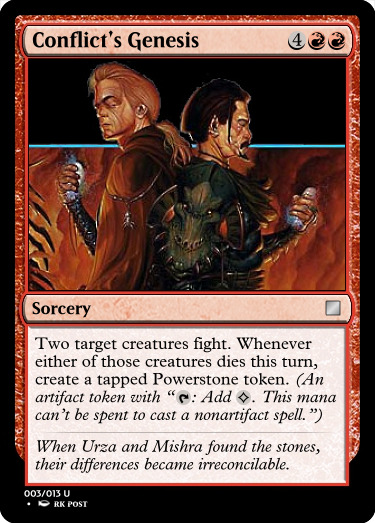
Conflict’s Genesis 4RR
Sorcery
Two target creatures fight. When either of those creatures die this turn, create a tapped Powerstone token.
I wanted to call this Sibling Rivalry, but a different card in the set already took that name. I like this card for it better though. I know neither Urza or Mishra died in that fight, but I think that was just mechanically better, and i think otherwise this is a great representation of the story. Two creatures on the same side fight, and two powerstones come out of it.

Steel Spinner 2
Artifact Creature- Spider
Reach
2G, T: Put a +1/+1 counter on target creature. Activate only as a sorcery.
U: Untap ~.
1/3
The set has lots of colorless artifacts with colored abilities, and I thought it would be neat to have a cycle of cards with two different colors of activation, so that it can go in either deck but is best in one with both. I’m particularly happy with this design and how the untap effect combines with a tap ability, and then this also serves as a mana sink for GU’s manaramp archetype. I added the reach to make the untap effect a bit more useful on its own.
Commons

Crystalized Prison 1W
Enchantment- Aura
Enchant artifact, creature, or planeswalker
Enchanted permanent is a Powerstone artifact with “T: Add C. This mana can’t be spent to cast a nonartifact spell,” and “6: Destroy Crystalized Prison” and loses all other types and abilities.
Here’s a weird pacifism variant. Since it turns something into a powerstone, I wanted to make sure they had something to spend that mana on, and I liked the gameplay of the expensive way to get rid of the enchantment. It let me cost this a little more aggressively.

Ruin Scrounger 2
Artifact Creature- Fox
Whenever a permanent enters the battlefield from a graveyard, surveil 1.
Unearth 1W
2/1
Here’s a common payoff for the RW unearth deck. Surveil in white may seem a bit odd, but I basically see surveil as useable anywhere scry would be, and this would absolutely be fine to scry, plus white even got a minor bit of self-milling so clearly this kind of thing is a bend they’re willing to make. I wanted surveil over scry for the unearth synergy, though I don’t love the amount of room it makes all the reminder text take up, and I can’t really skip out on a common. I think this’ll play great though.

Fluid Metamorph 5
Artifact Creature- Shapeshifter
Prototype 1/3 1U
1: ~ gets +1/-1 until end of turn.
3/5
This card was made because I had a) no prototype designs and b) no blue commons, so I tried to make a card that filled both holes. Technically, the common prototypes all came in a cycle so this breaks that pattern but. Eh. I might have done a bit more with prototype, it’s a neat mechanic, but I didn’t have a prototype frame and that annoys me.

Microtog 1B
Creature- Atog
1, Sacrifice another creature or artifact with mana value 3 or less: ~ gets +2/+2 until end of turn.
1/2
The first atog card was in antiquities, and it has been wayyy too long since we’ve gotten an atog so I thought making one would be a fun throwback. I took a look at set themes, and thought about what kind of atog I could make that hadn’t been done, and this is what I came up with, tying into the WB theme of caring about cheap stuff and of course, the RB sacrifice theme.

Fleshscrap Scavenger 4
Artifact Creature- Phyrexian
When ~ enters the battlefield, mill three cards.
Unearth 6B. This ability costs 1 less to cast for each other creature card in your graveyard.
3/3
Something I wanted to do with unearth was try out variable costs, and this was one of the simplest ways to do it, especially since other cards in the set care about the same thing. This might need a second black mana pip but I think ultimately, 1 mana for a very temporary 3/3 and milling three cards with a lot of setup is probably fine.
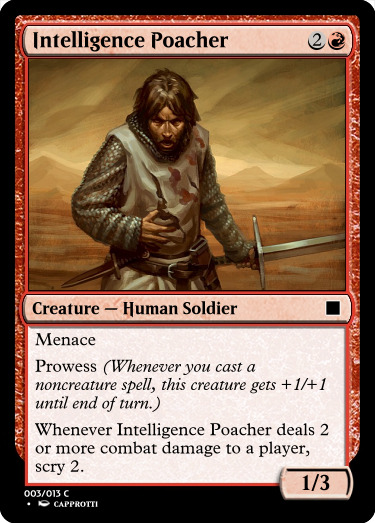
Intelligence Poacher 1R
Creature- Human Soldier
Menace
Prowess
Whenever ~ deals 2 or more combat damage to a player, scry 2.
1/3
Here’s a design I’m quite proud of, in terms of innovation at common. Having a threshold for the damage it needs to deal in order to trigger means you need to cast a spell to trigger prowess, or have some other means of boosting the power. I think it’s a really cool way of caring about noncreature spells on a prowess creature, by tying it to the prowess.
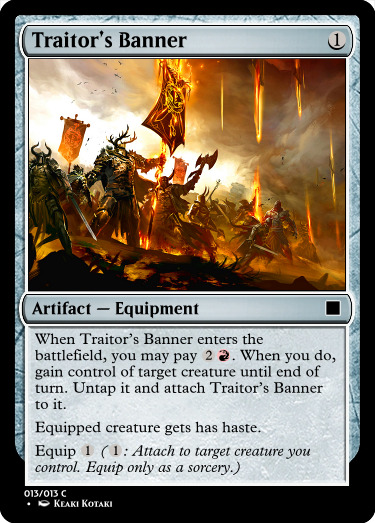
Traitor’s Banner 1
Artifact- Equipment
When ~ enters the battlefield, you may pay 2R. When you do, gain control of target creature until end of turn. Untap it and attach ~ to it.
Equipped creature has haste.
Equip 1
This is another design I’m quite proud of, I like how the base effect of the equipment ties in with the kickeresque effect, since that effect needs haste to work. I’m really happy about this as a common, and how viable it is in either mode.
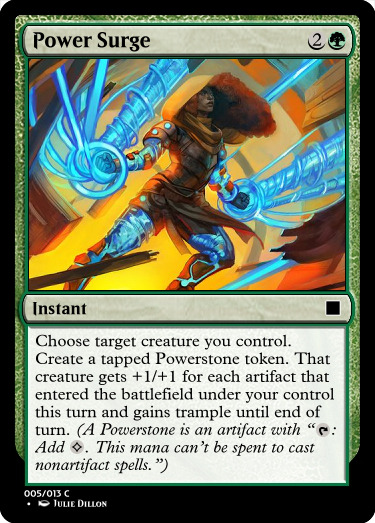
Power Surge 2G
Instant
Choose target creature you control. Create a tapped Powerstone token. That creature gets +1/+1 for each artifact that entered the battlefield under your control this turn and gains trample until end of turn.
Really not much to say here. There’s a GW theme of caring about artifacts entering the battlefield, and this plays into that and uses a Powerstone token to give it a base use case and the trample helps with that too.

Mishra’s Panther 3
Artifact Creature- Cat
When ~ enters the battlefield, you gain 3 life if mana produced by an artifact was spent to cast it.
3/2
I’ve always liked cards that care about artifact mana, I made a similar one in my booster for MH2, and with powerstones all over the place I wanted to revisit that here. Originally this scaled with each mana spent to cast it from an artifact, but I decided to make it a flat on/off instead for the sake of simplicity and being more usable in general decks, especially since “artifact mana” isn’t really a theme other commons care about.
Archive

Sigiled Wheel X2
Artifact [rare]
~ enters the battlefield with X charge counters on it.
Creatures you control have protection from the mana value equal to the number of charge counters on ~.
2, T: Add or remove a charge counter from ~.
Reprint slots are always hard for a project like this, since I have to make a new card. The conclusion I came to was to create a card that doesn’t feel like it would have been created for this set, and that fits in with the other reprints. One of the best ways to do this is to use a mechanic that isn’t really used in the set. Here I made a card that would have felt right at home in mirrodin block, but this set isn’t really doing much with charge counters, so it doesn’t quite fit in with what this set is doing, making it perfect for the reprint slot. I went with the mystical archive frame cause I didn’t have the old frame available.
6 notes
·
View notes
Text
[...]
hm. [?] pay no mind, it’s one of those bed mumbles and waves it off type of hours. the sudden tidal wave of embarrassment that comes after fixation is coming around...
note that all of these type of text posts are prefaced with an “I Think That [...],” and to avoid the search system, I usually, um. shorthand the names. you’ll see. you’ll understand.
moving on.
>
through game and programming shenanigans, I imagine they came into existence at the same time; however, I’d suppose that maybe seniority can be designated from left to right of the markers in [ACT II] as a form of “who was designed first?”
you begin with the long-lived, death (and life); that of beasts and the like follows after. this to be advanced by technology, and to incorporate fantastical elements: you bring in magicks. (though perhaps that one can be attributed for VisualFlair to an inane degree? the process for that one in particular however is rather...)
(alternatively you can go with who opens their [eyes] first in the scrybe intro, which would be :: Lshy -> Grmra -> Mgnfcs -> 03 :: but I don’t think that’s As fun, and it’s a little bit of its own headache to look at the markers that way... for me. ‘cause my brain is as smooth as a flatworm.)
and while timelines are weird to consider, I suppose it can always be excused by tossing in “[character] background settings” and interactions?
grmra favoring exposition and characterizations, lshy enjoying the aspects of environment/atmosphere and storytelling... they seem like they would, at the least, be an agreeable duo together given that they are tied in together (literally. hello islands). I mean. gestures vaguely. decent regards to subordinates. the whole deathcard thing? bro.
slide 03 in, that one for standard rules and gameplay. of course something as mechanical as it is would find more interest in mechanics - its deck is almost seemingly the easiest to grasp at the start, and not one person will play the same starter deck the same way. the variables are many. and while it may behave like a sore-loser and blame a loss on RNG (since, hey. it’s had to have calculated a bunch of simulations with various things), I just. I don’t think that given the chance outside of the whole [wanting you to win for the great transcendence] that it would have done things like lshy did. -> eight grizzlies example among some other things. it can accept (inwardly) a few times that the challenger may have made some good deck decisions and/or synergies. there’s no self-[] and pain involved in its campaign either - you just need to strategize and keep at it. ‘course, that means the cards are just factory-churned and doesn’t have possibly as much sentimental values as other things, but they serve their purpose well enough, don’t they?
(gently touches the ground. there is something to say about 0lly here as well in the suppressed curiosity and idealized outlook on the web but. flails and flounders)
I mean. mgnfcs is an obvious thing of visuals, but then everything else feels rather lacking as a result and maybe awfully long-winded (the gems...), though I suppose that’s his own way of making you feel impressed and immersed in the game the heart of the cards. ????????
>
I don’t really have anywhere I was going with this, but I just like their respective designs and themes... it’s really cool.
lshy: standard bell and scales, a campaign map where you can somewhat see in advance routes you can take with its own nifty details. it’s a matter of replay and a few more rounds. you sacrifice squirrels and co and your cards lunge to attack.
grmra: no bell but a pulley system and a cool pointer hand, a board with figurines. probably cool ass bosses with a load of personality and spunk to them (considering that one guy will commit vehicular manslaughter). you are graverobbing bones and your cards will knock them dead.
03: bootleg lshy [/j] // lots of mechanical/techy nonsensery, the scales tell you outright that you are in [DANGER] if you are a point away from losing which is cool, and it’s a set-up of forgiving (in that you do not restart as a “new player” but continue challenging from the same file) exploration with pre-determined battles and patterns. there’s a recharging system and you just fucking shoot them with a gun.
mgnfcs: I’d like to know, honestly, what his would have been like. maybe it would be grandiose and tacky. pictures can say a thousand words, so maybe it would be a matter of interpreting things yourself. also you get to see Cool Live Things conjure Cool Spells for you.
dunno, dunno... think I just need another nap.
#[is.txt]#|| > they mean world to me#sighs... man. I just. dang bro.#I know they're in too much of a power struggle to ever actually combine elements w/ each other but wow that would have been. a Whirl.#all this bc I was thinking abt the hilarity of if their islands were connected at one point but then they all got divorced. just kidding#one of those... -> ? how much respect they may have had for each other even if they all hated each other at varying degrees and if and when#they just chilled and got to play each other's games and had their own criticisms about it to see slight improvement/development later on#as a result... I think that would be Cool .#subtly fine-tuned rules. added character. slight environmental additions. visuals...#things that would seem as a sure thing to anyone else but are subtly picked up on and endearing to them over time#or am I bastardizing all of this too hard. LMAO#I'm like. steeples my hands. text-based game no need for any actual images when just words and numbers are enough but mgnfcs insists#otherwise or at the least on More Improvements ..........#<- which is why I want to go with the initial thought I had with the markers versus the. you know#|| > but that's just a BED CERTIFIED POOOOOST I am going from my chair right into a nap I have something I actually need to do today and#prattled on far too long oopsies. thanks if you read all of this for some reason it makes me feel like I got a head pat
7 notes
·
View notes
Text
Interaction Satisfaction Commentary
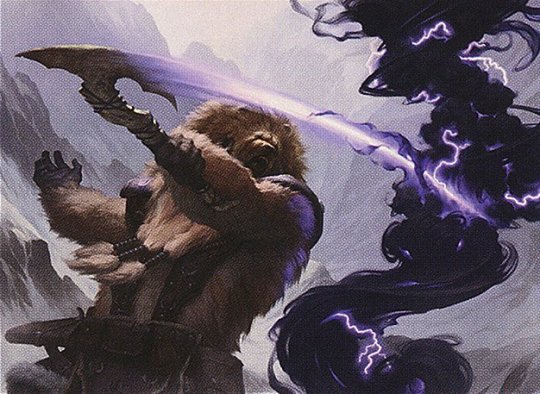
Hey everyone! It's been a while since I've run a contest, but this one has been lingering in my mind for a while.
There were two things I was really trying to pay attention to this contest: if the card fits in the deck, and if the card will always do something. I'll address the latter first: I wanted to make sure that the cards would always do something. The thing about interaction is you need it most when something is going wrong. Yes, sometimes you need a counterspell when you're winning to make sure you keep winning, but most of the time you need it because if you don't, you're sure to lose. Because of that, I really valued cards that always had some sort of effect, but also had some synergy tied in.
As for the deck concerns, that's a little more straightforward. Look at the deck you're putting the card in, then see if it wants these types of cards. There were only one or two entries that felt that far off, and removal is always going to do something, but it was important to me to think of the archetype as a whole, rather than just picking a random mechanic to tie the effect to.
But enough chatter. Here's the commentary:

@bergdg - Defend the Ramparts
A very narrow effect, but there are a few archer decks out there (I should know, I play Greatbow Doyen in my crossbow deck), and this is obviously built for them. There’s also quite a few cards that are incidentally archers or rangers that have deathtouch or a lot of power, so this is a removal spell in decks like that. This does feel very strange as an enchantment, though. I think I’d prefer this as an instant that puts counters on things, both because it already acts like that, and because I don’t like the idea of blinking this for repeatable removal. Speaking of which, I think you could probably cut the cost just a bit to three mana. It’s a narrow effect, and this is commander we’re talking about, so 3 mana removal with a little upside and a little restriction feels just right. I do really love how well it fits into what archer decks want to so; i.e. dealing direct damage to creatures.

@buzzardonic - Reboot
This is a very strange card. The most obvious use for this is to protect your artifact creatures from creature based removal. A lot of targeted removal these days aren’t specific to creatures, so it won’t protect from an anguished unmaking or the like, but it helps with a lot of the wraths in the format. It also keeps them in play, which means your artifact creatures with static abilities you want, like a lodestone golem, will still be in effect, which is an advantage over phasing out. There’s also in theory some combos you can pull of that require your artifact creature not being a creature, or even just to grant haste. The biggest detriment is just how incredibly narrow it is. Even in an artifact deck, in order for this to be worth the card slot, you have to have the mana up in just the right spot. I wish this did just a bit more, like untapping the creature or putting a counter on it. The other thing I worry about is weird situations like using this on Rusted Relic, vehicles, or with march of the machines. I think commander is complex enough that people might expect it, I just don’t know if it’s warranted on a card that could be achieved in other ways. Oh, and the flavor is great. When I read the text, I was wondering how you could flavor it, and it felt so perfect.

@coolcoolcooltighttightight - All-Out Assault
This is a really cool card, but it has a lot going on that I need to pick apart. First, it deals X+2, which is a big deal, as it means it’s never quite dead, but you definitely want to be leaning a certain way to have it do what you want to. Second, it says battle, which is really cool and fits the flavor, but awkwardly is a detriment because of that last line. If you want to defeat one of your own battles and you accidentally fulfill that last line, you’ll end up dealing damage to yourself. Oops! Lastly, and you might have seen this coming, but that middle part is very confusing to read. There’s a double negative in “control no untapped” which is awkward, and also the fact that you need to make sure they control a creature feels a little tacked on. In general, this card is very well designed as a removal spell with potential upside that fits very well into a certain archetype, but I think you needed to scale back a bit. Maybe just always deal damage to the controller? Or just always deal X damage to both? There are a few ways you could have gone to simplify the card a bit, and I think it would have been worth it to be able to cut some of the more awkward templating here.
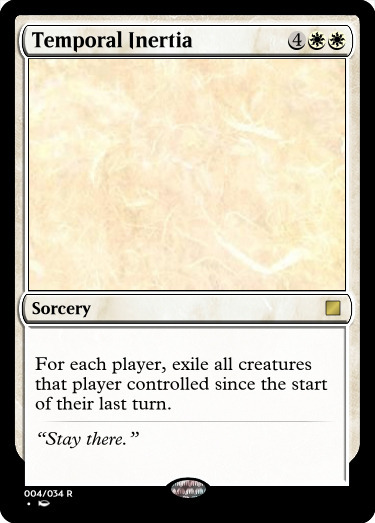
@corporalotherbear - Temporal Inertia
While I see what you’re going for here, I think it’s just a little too weird. My biggest concern is just how complicated board states can get in commander. If you ask someone which creatures they’ve controlled since their last turn, I think most people would be able to remember, but not everyone, especially on turn six. I also think the phrasing could maybe be a bit better, though I don’t know how. It takes a second to understand what the card is asking for. There’s also some weirdness with the play pattern. While this is obviously best in a blink deck, due to how mana curves work, this is most likely to leave behind only the most threatening creatures, which makes this an odd wrath closer in line to something like the ones that leave a creature behind like single combat, which are widely considered to be pretty unplayable. I will say, though, that as weird as this card is, it isn’t bad or poorly designed. It just feels a little off in how it’s phrased and how it functions.
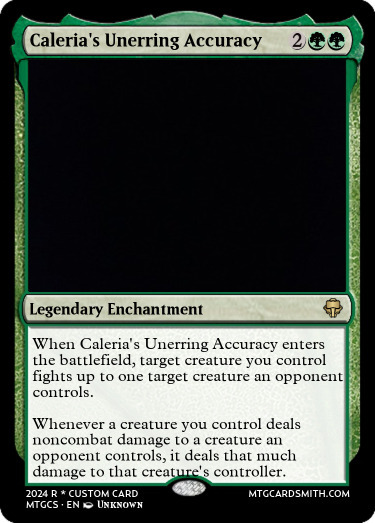
@fractured-infinity - Caleria's Unerring Accuracy
A four mana removal spell needs to have a pretty big upside especially a fight spell that can be so easily blanked, but this one has a lot of power. A fight deck could use this card to deal a ton of damage to players. A single Apex Altisaur could very likely kill the whole table. I think you could probably reduce this down to say “excess damage” similar to ram through to drop it down a little bit from win-con to value, but I understand that you’re playing a four mana enchantment, so it needs to be strong. The biggest strike against this card is I don’t think it can be mono-green. Dealing so much damage to an opponent’s face, even if it requires having creatures, feels like a color pie break. We’ve even seen cards that do something similar in red, like Toralf and Repercussion, and while I understand that the first half and the decks that want it are green, I think the card itself needs to be at least partially red.

@jestingmaniac - Behold the Beholder
Art desc: a beholder (dnd monster) fills the top 2/3 of the frame glaring down at a petrified group of four adventurers. Behind the beholder other petrified statues are dimly visible in the darkness.
While the concept here is pretty solid, there’s a few things that need to be addressed. First, the templating. You’d probably want to target creatures. There’s also some specific phrasing you might want to use: “For each player, turn target creature that player controls face-down.” But you might also want to specify non-token, or only face-up creatures, or say “up to” so that you can choose to skip a player (like yourself), though that last one might go against the theme of the contest. After all, you want to play this in a morph deck, right? Second, the reminder text. That’s not the default of what a face-down creature is (they are assumed to be 2/2 creatures with no name or ability), so you need to treat it like normal rules, not reminder. Look at a card like Tezzeret, Cruel Machinist, which turns cards face-down but then describes what they turn into. Lastly, I want to talk about the effect itself. Turning creatures into 1/1s that tap for colorless is odd, but not terribly out of place. I like how, in commander especially, it feels sort of like “fair” removal. It gives everyone something relevant. So yeah, even though there’s some weirdness with the card’s text, the actual effect I rather like.

@just--a--penguin - Triumphant Charge
I think this card is fine, but takes the risk of going all-in. The point of playing interaction in a deck is often to deal with something that your deck can’t handle. If your lifegain deck is being shut down by something, you need to be able to get rid of it. If your opponent has an Elesh Norn (either one) and you can’t play your soul wardens, you need to kill it. But this card can’t really do that. If your deck isn’t quite working, then it will continue to not work. If your deck is working, then this will help you out a little bit. However, even then, this card feels a little weak. Putting a few counters on a few creatures, or even all of your creatures, seems nice, but usually won’t make much of a difference, especially since most of your creatures are either 1/1 soul wardens or 20/20 ajani’s pridemates. Killing a big creature is always going to be nice, but I think with this much of a condition, you might have been okay just killing anything. White can do that every so often, especially in commander. Like I said, while the card effects are fine, I think as a whole it’s just going too all in for not that much of a reward.
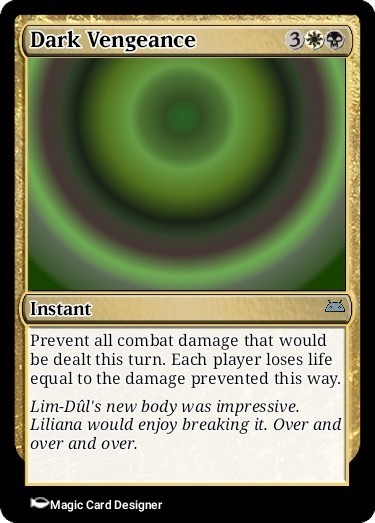
@snugz - Dark Vengeance
This one feels a little out of place this week. I don’t quite know what deck archetype this is aimed towards. It just feels like a generically good card, maybe leaning a bit towards orzhov life drain decks, but not in a particular way. I guess it’s better in life gain decks? Well, anyway, the card seems fine. Like a lot of rattlesnake cards, I could see it causing frustration, what with turning a winning attack into a losing attack, but that’s just how it goes. There’s also some awkward timing with the spell, since it implies you lose the life right now, but I think you’d lose it when the damage is prevented. I thought it was actually incorrect templating, but there are plenty that say “You gain life equal to the damage prevented this way” so this wouldn’t be much different. While I think the card is alright, it feels a little off the mark for this week’s contest.
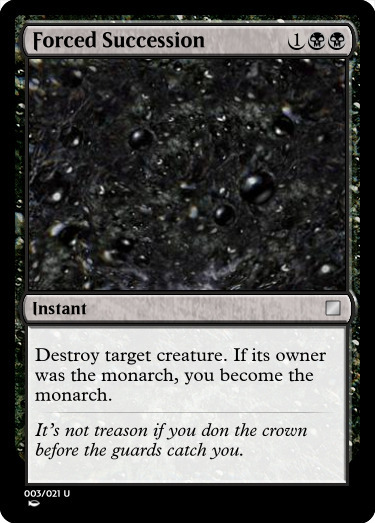
@sparkyyoungupstart - Forced Succession
Strictly better murder is acceptable in my book. No one plays murder anyway. I love the flavor here. While the effect feels narrow at first, the way monarch works is actually very well suited to interaction. It’s about the only mechanic where if you play with it, everyone is playing with it. The simplicity of this card and the way it understands the deck it would be in impress me. However, it being an instant kind of rubs me the wrong way. Someone attacking the monarch and gaining the monarchy, only to lose it and one of their creatures after combat but before they draw seems rather punishing. It’s effective and plays to the mechanics, but it plays against the type of experience I think a monarch player wants. If you’re playing a monarch deck, you probably expect it to move around a bunch. If you didn’t, then you’re probably not playing the deck right. Similarly, this allows a player to receive the monarchy without risk of either attacking or tapping out main phase for an effect that grants it. It feels like it’s playing against the themes of the deck even if it’s playing into the mechanics of the mechanic. I still think it’s great flavor and great simplicity.

@stupidstupidratcreatures - Nibble
There are two main decks I can think of for this: rat decks and one-damage decks (AKA Ob Nixilis Captive Kingpin decks). It’s a little awkward because rat decks, even though they play a lot of things that make 1/1 rats, also play a lot rats that get really big from other rats. Ping decks, on the other hand, probably don’t really need a way to grant -1/-1 all that often, since they’re playing red pingers that do something similar. Even so, maybe this is still enough. At worst it’s a more expensive rat out that makes a rat that can block, which isn’t awful. Fourth Bridge Prowler with flash isn’t half bad. And I have to admit, I just love ping-matters, so maybe this is just personal opinion, but I love this card. Four 1/1s and four -1/-1s for two mana is pretty high above curve, but even one extra copy is nice, and no extras can still kill an annoying creature some of the time. My one change I would make is say player, just so you could get an extra one from your phyrexian arena. One last thing I wanted to mention: I’m really glad that this checks when it’s cast rather than resolution, so players can’t ping themself with something in response so you get fewer copies. While it’s a little misplaced in the decks that want it, I still think it’s a sweet card.

@wildcardgamez - Fade into History
Wow, that’s some very powerful history. Removal in a saga deck is kind of odd, since a whole lot of sagas already are removal, but there aren’t really many that directly deal with artifacts or enchantments (since putting them in later chapters might be weird timed, and putting them in early chapters makes players not want to play them even if they should so they can get later chapters). I like the exile here for flavor and power reasons, since it’s a little narrow for what most people play nowadays. The weirdest thing here, though, is the sheer amount of lore. Anything more than two lore counters seems excessive. I don’t like the idea of skipping forward on a saga so explicitly. Something like proliferate is a little slower and has more nuance, but this feels like skipping to the end. It means you don’t get the fun, slow planning involved with a lot of sagas, and instead do everything at once. It feels like it’s removing a lot of what makes sagas unique. But that is probably a matter of taste. If you’re trying to power out sagas and do them all, then this card will do that. Plenty of people would play this card, and I wouldn’t say they’re wrong to do so, I just thing it makes playing sagas a little less quirky.
~
And there you have it, all my commentary for the week. Thanks again everyone who entered, it was fun giving this another spin. Next week is going to be great, if you're game for it.
-Mod Mr. ShinyObject
7 notes
·
View notes
Note
Let’s look at the sets that have come out since their release:
- Dominaria United: Has them (three cards)
- Brothers’ War: Has them (one card)
- Unfinity: Doesn’t have them (was originally slated to be released before dominaria united but got delayed)
- Warhammer 40k: Doesn’t have them. (Maybe delayed, I can’t remember)
- Jump start 2022: Doesn’t have them.
- Phyrexia: All will be One: Doesn’t have them (to avoid proliferate synergy there wasn’t time to test for)
Admittedly, 2/6 releases is a bit unusual for an evergreen mechanic. But this doesn’t mean they’re not evergreen. For one thing, I think a lot of people are expecting them to be used on several cards in a given set, cause that’s what a lot of evergreen mechanics are like. But stun counters aren’t like that- they’re just a replacement for “doesn’t untap during its controller’s next untap step”. (And notably, since the release of stun counters, we haven’t had any new cards like that.) And while that’s a useful effect that we do see in most sets, it isn’t an effect that goes on a lot of cards in a given set. New Capenna, Neon Dynasty, and Crimson Vow each had only two. Midnight Hunt had only one. It’s a roleplayer effect, but not one that a set usually needs too much of. So stun counters are never gonna be a huge thing, they’ll just be slow and steady. And the other thing is, because of their nature as roleplayers mainly on commons, sets like Jump Start and Commander Decks that tend to use reprints for their roleplayer cards might not make any. Note that the original jumpstart didn’t have any new “doesn’t untap during its controller’s next untap step” cards, and that only one commander precon new card ever has used the effect. It’s mainly something you should expect to see on limited commons. So it’s really not weird that neither J22 nor 40k used them.
So basically, yes, they are evergreen, and there’s no reason not to expect more of them in most standard sets and a lot of draft-based supplemental sets. Phyrexia was an exception not a rule. Just don’t expect a lot of them, cause that’s not what they are.
You should have waited to announce stun as evergreen. When you said it, it was not yet true. Stun is clearly deciduous at best and is transitioning into evergreen
Talking from two years in the future can be tricky. It's evergreen to me and will eventually be evergreen to you.
Interacting with me comes with some of this chronal displacement.
80 notes
·
View notes
Text
Krenko’s Guide to Creature Types: Naga

The most beautiful woman in all of MTG, by James Ryman
What is a Naga (flavorfully)?
In Asian mythology, Nagas are a type of divine being that are somewhere between human and serpent, depending on the individual myth. Some are basically humans with serpent iconography, others are basically snakes that happen to be able to talk. They’re generally pleasant and benevolent to humans, and they usually have some sort of power over water.
In Magic: the Gathering, Nagas are snake people (also called ‘sneeple’) with arms and long tails, enabling them to give even better hugs than normal snakes. Female nagas have no breasts, though as they wear similar fashion to humans their clothing often gives the illusion of breasts. Imoti has extra arms for unknown reasons.
Nagas are primarily native to Tarkir and Amonkhet, and while the species is roughly the same, Tarkir Nagas seem to be a lot meaner.
What is a Naga (mechanically)?
Naga is a race creature type, usually attached to a class. Nagas are primarily blue or green, save for the one White Naga that doesn’t actually exist, and the couple of Zombie Nagas, which are of course Black. Other than that, Nagas don’t have any sort of unifying mechanic. The closest they have is the Exploit mechanic, which is the Sultai mechanic rather than a racial specific one.

Can I make a Naga deck?
Unclear!
For a sixty card deck, there’s certainly enough decent Nagas that you can build a sixty card deck with competent creatures, turn them sideways, and put up a threat against other casual decks. There’s not quite a critical mass of Nagas to start making actually good decks out of them, but it’s basically fine.
In Commander, Sidisi, Brood Tyrant, is a fun and interesting commander whose ability works well with Exploit and many other incidental Naga abilities. With only 37 other Nagas in Sidisi’s colors, you’re going to be a bit tight getting good creatures, but the deck can still be plenty of fun. Many Nagas reward self-mill strategies, others are happy to use Exploit to sacrifice the Zombie tokens Sidisi makes, and others are just good in their own right. It’s not going to be Earth-shattering, but it’ll be fine for a casual table, and the various weird synergies can be a lot of fun.

Is Naga a good creature type?
Naga… means Snake. Yes, there are distinct mythological beings called Nagas, and I understand the desire to distinguish them from snakes, but there’s one major problem with that from a gameplay mechanic, and that’s the Orochi. Orochi, the sneeple from Kamigawa, are creature type Snake and aren’t really distinguishable from the Naga in any reasonable way. Some Orochi have legs, but many don’t. Orochi women have boobs, but that’s actually more of a Naga trait than a Snake trait. Orochi have four arms instead of two, but that’s definitely not a Snake trait in any sense of the word.
The reason this matters so much is that Orochi have a number of cards that care about the Snake creature type. Naga could easily have joined the Orochi to encourage Snake decks without much power level concern (as Snake isn’t a particularly strong type right now), but instead they have their own type that’s, for the most part, useless.
The Naga debate has happened plenty, but ultimately I think the general agreement is that adding creature type Naga was a bad idea and they should all have been Snakes. I just wish Wizards would be willing to errata away their bad idea. It’s not like they haven’t errata’d plenty of other types over the years.
#Krenko's Guide#Naga#Snake#I am seriously in love with Naga Vitalist#Someone please tell me she survived the Hour of Devastation
38 notes
·
View notes
Text
Pokemon Card of the Day #2383: Tsareena (Sun & Moon)

Tsareena was a really hard Pokemon to figure out. Its Ability was incredible when you first looked at it. Being able to look at the opponent’s hand and discard their best card was quite powerful, and there were quite a few times where that would badly slow them down. You’d expect that to make Tsareena an automatic threat, and then things started to become more clear. This was an Ability that only worked when evolving to Tsareena, and Tsareena itself was a Stage 2. You’d only get a couple of chances in a game most of the time... except Tsareena was a Grass-type, so Forest of Giant Plants was still available in that PRC-On format. That made things easier. And still, it was a ton of deck space for hand disruption, and with Tsareena being a poor attacker deck building would likely be hard. The potential, and the problems to overcome, were both massive here.
140 HP was slightly lower than some of the other Stage 2 Pokemon out there, which were seen at 150-160 quite often by this point. 140 still wasn’t easy to push through quickly, but you did have to consider some common combos. Decidueye-GX’s Ability put Tsareena into KO range for Golisopod-GX, for example, and Greninja BREAK+Greninja could do the same. On the other hand, more straightforward attacking situations didn’t change too much. The Fire Weakness, as usual, meant that Volcanion decks (as well as the likes of Salazzle-GX) were going to be a major problem, and Tsareena’s Retreat Cost, at 2, made ways to recover from that important. You’d probably want to consider cards like Super Scoop Up and Acerola to recycle Tsareena, since it wasn’t like it was doing anything but taking up Bench space while in play.
Queenly Majesty was one of those Abilities that may have been overpowered on a different Pokemon. It was still very good if you could get into the right situation. It worked when playing Tsareena from your hand to evolve 1 of your Pokemon, and you were able to look at your opponent’s hand. You then chose a card from their hand and discarded it. Being able to choose which card was discarded could be quite powerful if there was something important there, and there were plenty of chances to put an opponent into a bad spot. There were plenty of ways to recover if, say, someone had a few good cards in their hand, but sometimes there would be spots where they’d have to hope to get a good card off the top of the deck. The real issue for the Tsareena user was that it was a Stage 2, and if you wanted any chance to re-use the Ability at a later point you couldn’t just use Rare Candy. You’d need a strong line of Tsareena, a Pokemon that didn’t do anything else, and while the potential synergy with Vileplume was there, fitting both and an actual attacker was almost impossible to build consistently. All of this balanced out a very powerful Ability and prevented it from becoming the next Rocket’s Sneak Attack.
Tsareena did have an attack, though it wasn’t very impressive. 80 damage was rather low for a Grass and 2 Colorless Energy. Yes, healing 20 damage from Tsareena was something, but that wasn’t enough to make the low damage worthwhile. Such attacks were a little better in the context of disruption, but you’d still want to lean on something a bit stronger.
Tsareena was a very volatile Pokemon. There would be games where it could get rid of an important card and make sure the game was rather one-sided for a while. There would also be games where the Tsareena player just didn’t get all the pieces that were needed, or the opponent had a hand where you couldn’t get rid of everything that would be useful. This put the card in a weird spot where nobody wanted to face it, and yet nobody wanted to use it either, with every game involving a lot of luck. It was probably a good thing that Queenly Majesty was put on a Stage 2 with little else going for it, because it would have been game-changing on something easier to access.
14 notes
·
View notes